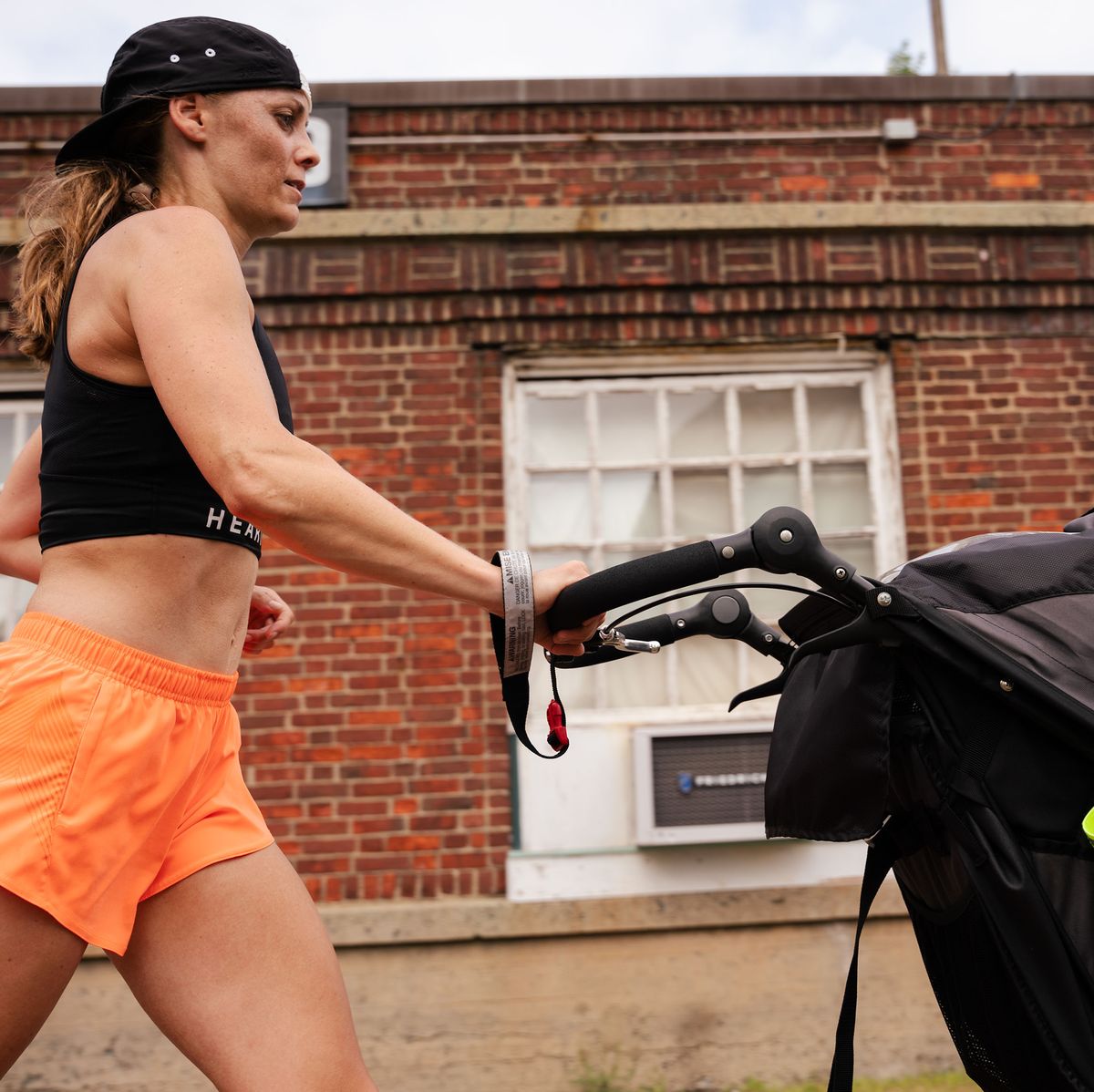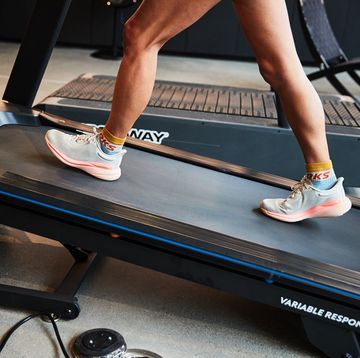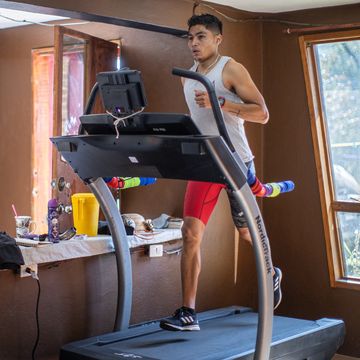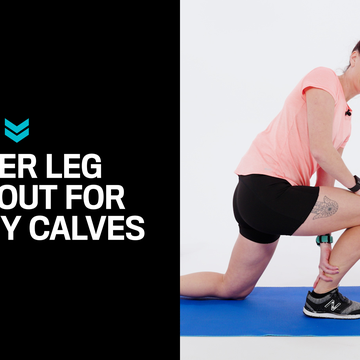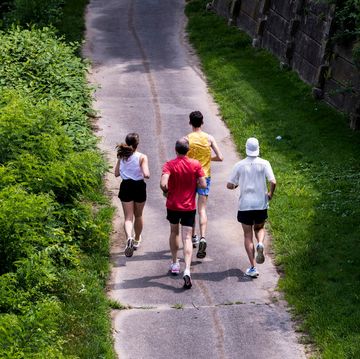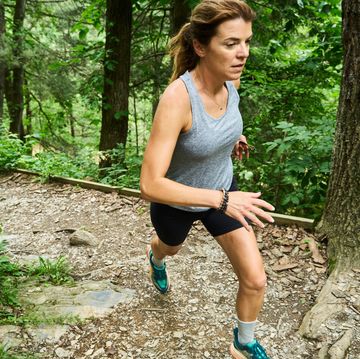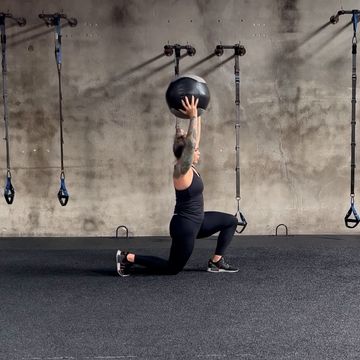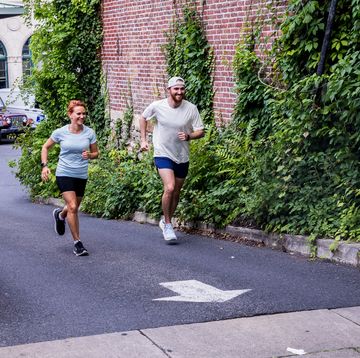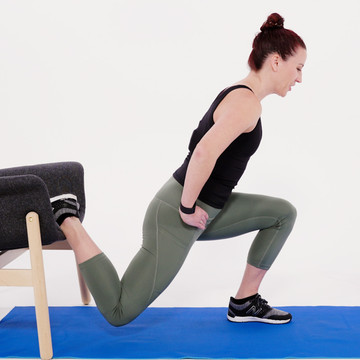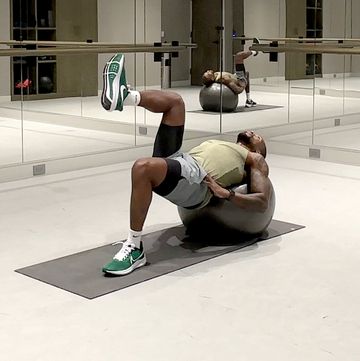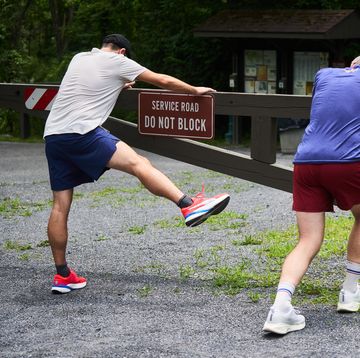Eleven months after the birth of her daughter, Josephine, Olympian Molly Huddle was back to racing and feeling glimmers of re-emerging fitness. On March 19, she ran 1:12:27 to place seventh in the New York City Half Marathon.
But five days later, the image no runner wants to post appeared on Instagram: Huddle on crutches. The soreness she’d thought was a hip flexor strain turned out to be a grade 3 femoral shaft stress fracture.
Utah-based runner Lexie Thompson saw the update and worried. Four months after the birth of her daughter, Chloee, Thompson was coping with adductor pain. She briefly wondered if her femur was fractured, too.
More From Runner's World

A simple form cue from her physical therapist—driving her knees up higher—relieved the ache and eased her mind. Then, about 45 minutes into a run on April 27, she felt a pain in her lower back so severe she could barely walk.
An MRI revealed a hairline fracture in her sacrum, an injury requiring three to six months off and dashing her hopes of qualifying for the 2024 Olympic Marathon Trials.
Neither Huddle nor Thompson had had a major bone injury before. Both had taken a conservative approach to returning to training. But they nonetheless join a growing list of breastfeeding runners who have developed bone injuries, including Olympians Shannon Rowbury, Paula Radcliffe, and Kara Goucher, trail runner Rachel Drake, and marathoner Neely Spence Gracey.
There’s typically no single cause of stress fractures, tiny cracks that form when bone is broken down faster than it can rebuild. But at the root of these injuries may be a small, short-term decrease in bone density at the end of pregnancy and while breastfeeding. Add on other factors new moms face—lack of sleep, higher energy demands, and biomechanical changes—and many face a “perfect storm,” as Huddle described her situation.
Experts and athletes alike say more research is needed to understand the risks and how to mitigate them—work that’s in progress, especially as more high-level runners have babies earlier in their careers. Here’s what we know now about contributing factors and what to do about them.
What causes postpartum stress fractures?
As a pregnant woman’s delivery date nears, calcium and other minerals are diverted to the developing fetus, said Erin Fredrickson, D.O., M.P.H., a family physician and runner in Seattle. If she chooses to breastfeed, the shift continues, as those nutrients go to produce milk.
Hormones govern this process: Estrogen regulates the breakdown of old bone and the growth of new bone. Levels rise during pregnancy, drop upon delivery, and remain lower during breastfeeding, said Jessica Rachel Starr, M.D., an endocrinologist at the Hospital for Special Surgery. Lactating also stimulates the release of parathyroid-related hormone, which tells the body to break down bone, Starr said.
All this means bone mineral density typically declines slightly around the time of birth—as much as 5 percent in some parts of the skeleton—and continues to decrease slightly throughout breastfeeding. (Some women develop a more serious condition called transient osteoporosis of pregnancy, but it’s rare, affecting an estimated one in 250,000.)
Bones typically return to normal strength within a couple of weeks postpartum, or six to 12 months for those who are breastfeeding. And the slip is slight enough that non-athletes likely wouldn’t notice, though some may have dental problems in this period. “However, for runners that are doing a high-volume load of training with a lot of mileage, a lot of intensity, this is kind of a two-hit phenomenon,” said Meghan Bishop, M.D., an orthopedic sports medicine surgeon, Olympic Trials-qualifying marathoner, and mother of two.
The same hormonal changes also often mean women aren’t getting their periods yet. So even as shifts in their bodies and demands on their time make it harder to tune into hunger cues, they can’t use their menstrual cycles to gauge whether they’re eating enough—and many aren’t, even if they intend to.
Recovering from birth, producing milk, and training all require significant fuel. “You have all these additional energy needs in a likely sleep-deprived individual who’s caring for at least one baby, if not multiple,” said Nicole Farnsworth, M.S., R.D., a certified nutrition specialist in the female athlete program at Boston Children’s Hospital, who’s also about six months postpartum with her second child.
Other pregnancy-related changes also can factor in. A hormone called relaxin loosens joints and ligaments to make birth easier, but may also alter running gait and biomechanics, contributing to both soft-tissue and bone stress injuries. So, too, can changes to your pelvic-floor and core muscles before and during birth.
And then there’s the pressure to lose baby weight and get “back” to prior fitness. That tension may have higher stakes in elite athletes who make a livelihood from their sport, but it affects runners at all levels, noted Melissa Streno, Psy.D., a licensed clinical psychologist and adjunct professor in the sport and performance psychology program at the University of Denver.
All this lowers the threshold for the types of risks that affect every runner. For example, Huddle stepped in a pothole and sprained her ankle a few weeks before her fracture. She and her doctors suspect compensation from the sprain contributed to her femoral injury, and also wonder if using super shoes with carbon fiber plates too frequently, too soon increased the forces through her leg when it was already unstable.
How common are postpartum stress fractures, exactly?
Anecdotal reports abound, but as with many other topics related to female athletes, evidence is lagging. In a 2019 study of 34 elite Norwegian athletes who returned to sport after giving birth, four of them sustained stress fractures postpartum. And in a paper published earlier this year in the journal Medicine & Science in Sports & Exercise, among 42 elite- to world-class runners, six developed postpartum bone stress injuries, including two sacral stress fractures.
Researchers are working to learn more, said Adam Tenforde, M.D., director of running medicine at the Harvard-affiliated Spaulding National Running Center. In addition to treating runners like Huddle, he’s coinvestigator on a large study that will assess injury risk across thousands of runners going forward, including those who recently gave birth.
Does this mean runners shouldn’t breastfeed?
In a word, no. Breastfeeding has benefits for both babies and moms—including, some evidence suggests, a reduced risk of fractures later on.
When the endocrinologist Starr treats athletes with other vulnerabilities—such as pre-existing low bone density or an eating disorder—she’ll discuss the pros and cons, and when to wean, in their specific situation. Still, she rarely advises against breastfeeding altogether.
Eventually, research might reveal more about the optimal timeframe for breastfeeding and weaning to minimize short-term risk for athletes. Still, “people are not just bones,” Frederickson, the family physician, said. There are many other factors that go into decisions about feeding babies, many of them emotional and personal.
Are there ways to prevent postpartum stress fractures?
Eating enough to power all your activities, including breastfeeding and training, is critical, said board-certified sports dietitian, runner, and mom Lauren Antonucci, R.D.N., C.S.S.D. Every athlete is different, but breastfeeding alone may require 300 to 600 calories per day. You might need bigger portions, additional snacks, or a combination of the two—with a focus on timing, ensuring you’re well-fueled before and after training and breastfeeding.
Calcium and protein are also high priority. Farnsworth suggests aiming for four servings of dairy or fortified alternatives per day to meet calcium needs (the recommended daily intake is 1,000 milligrams per day). Small doses in food are easier for your body to absorb, but taking a supplement may help if you’re still falling short.
Also, talk with your doctor about testing vitamin D and ferritin levels. Many breastfeeding women, including Huddle, are low and may need supplements. Some may also choose to keep taking a prenatal vitamin—or another multivitamin—as an assurance on other micronutrients.
All this may feel easier said than done for busy moms. If you’re unsure or struggling, consider consulting a sports dietitian, who can give guidance on what and how much to eat and practical advice for making it work—for instance, Antonucci suggests drinking a calcium-rich latte or eating a cup of yogurt each time you feed your baby.
On the training side, gradually reintroducing impact allows bones time to adapt and grow stronger. Pelvic floor physical therapy can address shifts or weaknesses in core or pelvic floor muscles, correcting loading patterns to reduce strain on areas like the hip and sacrum.
Time-crunched moms are often tempted to skip steps like warmup and recovery when they return to running. “That’s often where I see injuries pop up,” Streno said. Instead, consider building them into your workout: If you have an hour to train, spend 45 minutes running and 15 minutes on mobility work and refueling. She also suggests cleaning up your social media feeds, unfollowing those whose posts cause negative feelings or invite unhealthy comparisons.
Finally, if you feel pain, don’t power through it. See a sports medicine provider if it doesn’t improve, and request imaging if the cause is unclear. “Having an increased suspicion that you could have a stress fracture could help you catch it earlier and be able to prevent prolonging the injury,” Bishop said.
No athlete wants to be injured, and the timing can be particularly frustrating for new moms. “It’s far enough out that you think you’re back and out of the woods, and you’re fit,” Huddle said. “If you’re shooting for a really big goal, it’s going to be around that one-year mark, and you really don’t want to take three months off at that point.”
But if it happens, extend yourself grace. Nearly all athletes sustain an injury at some point, and many factors are beyond a runner’s control. “There’s so much physiological, emotional, and social change that goes on in such a short period of time,” Farnsworth said. “We may do everything we can to mitigate the risk, but it doesn’t ever eliminate it.”
What’s the long-term outlook?
Healing a stress fracture requires rest and a similar approach to nutrition—eating enough for recovery and breastfeeding, with a priority on bone-building nutrients. Huddle also received bone-stimulating and shockwave treatments and has worked closely with her chiropractor on her biomechanics.
Both she and Thompson have made progress. Thompson was cleared to return to the elliptical in late July, and Huddle is back to hard workouts again, with eyes on returning to racing in August or September.
Anecdotes and evidence alike point to positive long-term outcomes for runner-moms, including those who have had fractures. For instance, British marathoner and former world record holder Radcliffe won the New York City Marathon in 2007, seven months after having her daughter Isla, then developed a stress fracture in her femur. But the next year, she won New York again.
In addition, the same study of 42 elite postpartum runners that included six fractures also found that within one to three years, most athletes had returned to similar levels of performance, and 56 percent of them got faster.
More research, and translating those findings into practice, could enable athletes to reach that point with fewer injuries. Fortunately, that’s beginning to happen: Orthopedic surgeon Bishop is working on a review article about musculoskeletal concerns during pregnancy and postpartum, to better guide doctors treating new moms.
In response to requests from Huddle, Tenforde and some of his colleagues are creating an infographic on postpartum return to running that they hope to publish soon; USA Track & Field (USATF) and &Mother, the nonprofit started by Alysia Montaño, are also working on resources for athletes. Huddle envisions a guide for returning moms that’s similar to what USATF provides regarding altitude training for athletes who make U.S. teams, perhaps including details about nutrient needs and a first appointment with a pelvic floor PT.
In her mind, the need is urgent: “A lot of women are timing things to come back for the Olympic Trials next year, and I just don’t want them missing a big chunk of time right before that,” Huddle said. “We need a little more guidance that’s readily available to everyone who needs it.”

Cindy is a freelance health and fitness writer, author, and podcaster who’s contributed regularly to Runner’s World since 2013. She’s the coauthor of both Breakthrough Women’s Running: Dream Big and Train Smart and Rebound: Train Your Mind to Bounce Back Stronger from Sports Injuries, a book about the psychology of sports injury from Bloomsbury Sport. Cindy specializes in covering injury prevention and recovery, everyday athletes accomplishing extraordinary things, and the active community in her beloved Chicago, where winter forges deep bonds between those brave enough to train through it.
